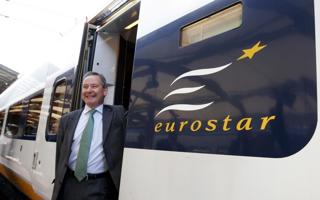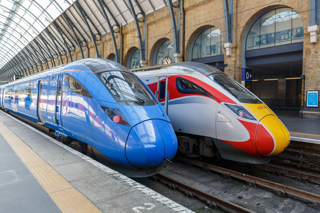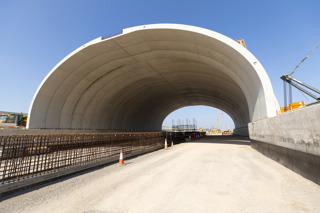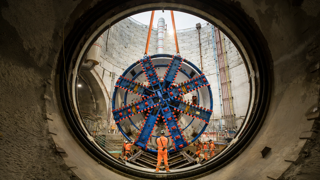A rolling rail electrification programme is crucial for economic growth, sustainability, and decarbonisation, says Caspar Lucas.
The new government has rightly said that rail is “emblematic of British ambition and innovation” and key to our economy. Yet one of our industry’s most transformative developments has received little attention to date.
A rolling rail electrification programme is crucial for economic growth, sustainability, and decarbonisation, says Caspar Lucas.
The new government has rightly said that rail is “emblematic of British ambition and innovation” and key to our economy. Yet one of our industry’s most transformative developments has received little attention to date.
Electrification scored only a passing mention in Labour’s manifesto, Getting Britain Moving: Labour’s Plan to Fix Britain’s Railways, with reference to a strategy to “create a stable foundation for innovation and problem-solving; allowing, for example, electrification to be delivered efficiently in due course”.
It was also noticeably absent from the King’s Speech briefing notes.
With only 38% of the UK rail network currently electrified (far behind many European counterparts), electrification should be at the forefront of the government’s rail agenda, helping to fulfil economic growth promises and net zero commitments.
Displacing diesel reduces carbon emissions, improves public health through better air quality, and (crucially) enables a better-performing railway that operates more efficiently, at greater capacity.
State of the (rail) nation
Readers hardly need reminding that Britain has never experienced a prolonged commitment to electrification.
However, projects are progressing: the Transpennine Route Upgrade between Manchester and Leeds; Wigan-Bolton; Glasgow suburban extensions to East Kilbride and Barrhead (under devolved Scottish governance); and the Midland Main Line as far north as Wigston (south of Leicester).
Power supplies on the northern section of the East Coast Main Line and on the Kent and Sussex routes are being upgraded, and the South Wales Valleys are seeing discontinuous electrification, with battery-fitted trains to bridge the gaps.
But there is no rolling programme, and no clear plan to complete the Great Western or Midland Main Lines, nor to reverse the omission of East West Rail.
After the public abandonment of Network Rail’s Traction Decarbonisation Network Strategy, the Great British Railways Transition Team has spoken of ‘no regrets’ schemes, but with only hints about what these might be - the Long-Term Strategy for Rail has not yet appeared.
In April 2024, the Railway Industry Association’s Delivering a Lower Cost, Higher Performing, Net Zero Railway by 2050 proposed a structured programme including a rolling stock strategy, but it does not have formal government support.
Trains too
We are currently at the tail end of a boom in passenger train supply arising from orders in the last decade. In some ways, it is only (very) late delivery which has kept UK assembly facilities busy.
But new trains will be needed by the end of the decade, and they clearly need to reflect the extent of electrification.
Rolling stock and electrification are less closely linked than they once were - the bi-mode (or even tri-mode) passenger train or freight locomotive can run without end-to-end power supplies.
This is valuable. The oldest diesel trains, for example Northern’s oldest ‘Sprinters’, need the replacement programme now in development, but the infrastructure will not be ready for them to be electric-only.
Conversely, in some cases - such as extending Great Western electrification - existing bi-mode trains can use the power as soon as it is approved for use.
Re-electrification included
We should also remember that rail electrification projects do not necessarily involve new routes.
As evidenced by the power supply upgrades that are under way, the existence of overhead wires (or conductor rail) on a route does not always mean that there is power for any more trains. Supply upgrades in themselves enable more use of electric trains.
Vulnerability to damage, increasingly from climate change impacts, is another reason for attending to existing electrified routes. The trains don’t support the economy if the wires are down.
In the summer 2024 update to its review of climate resilience, Furrer+Frey identified five routes where the electrification infrastructure is at particular risk.
Re-work of existing, ageing power suppliers is an integral part of a strategic electrification programme. It requires design, supply and installation effort, just as brand new schemes do.
Priorities, process and prize
The heart of a rolling electrification programme is the planned, strategic prioritisation of individual projects to maximise the value of each investment implemented, each time building the case for the next one.
Schemes need to be of manageable, Treasury-friendly budget and size, ensure effective low whole-life carbon, and be programmed to provide a steady stream of work to the supply chain.
We should maximise value, but not just in terms of capital expenditure. Overall value to society is a composite calculation, covering financial measures and operational efficiencies as well as carbon reduction (through modal shift, and the development of low-carbon whole-life infrastructure and associated low-carbon manufacturing) and environmental and health benefits from emissions reduction. These factors need to be quantified and included in the prioritisation process.
The programme needs to encompass passenger and freight, trains and infrastructure, in line with the government’s strategy and ambition for Great British Railways and the decarbonisation of the economy.
There needs to be short- and medium-term prioritisation, with a rolling horizon allowing for reassessment of more distant prospects as market and technological conditions evolve, but always knowing what the next few schemes will be.
A rolling programme would take up (and then grow) the industry capacity that exists now for current projects, enhancing it to build in carbon reduction and sustainability, and not losing expertise when the last scheme is finished.
To start with, we should declare now which projects present ‘no regrets’ investment and plan for them.
It’s aligned
The Labour government has shown that it is committed to early action. An efficient rail electrification programme is fully in line with the party’s manifesto on transport, economic, environmental and industrial policy grounds.
Electrification is best undertaken as an ongoing process with strategic oversight of the whole railway system, as proposed in Getting Britain Moving.
A rolling programme would provide certainty to the value chain, incentivising investment and generating further efficiencies, benefiting both infrastructure and rolling stock suppliers.
The result: a rail network that is both more attractive and has more capacity for passengers and freight, supporting the economy to achieve the growth needed for the government’s policies to succeed, while driving solutions for a sustainable, lower-carbon, climate-resilient transport system and industry.
Caspar Lucas is a chartered engineer and technical director in AtkinsRéalis’ Rail Consulting Practice.
The contribution to this article of Jon Casey, Associate Carbon + Sustainability Consultant at AtkinsRéalis, is gratefully acknowledged.
Login to continue reading
Or register with RAIL to keep up-to-date with the latest news, insight and opinion.


















Login to comment
Comments
No comments have been made yet.